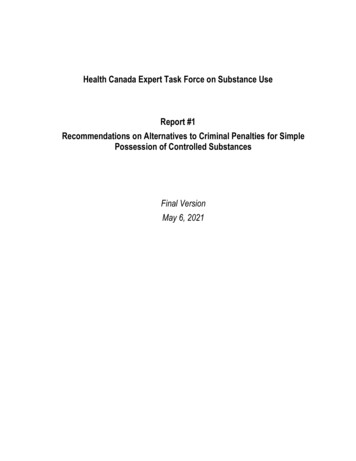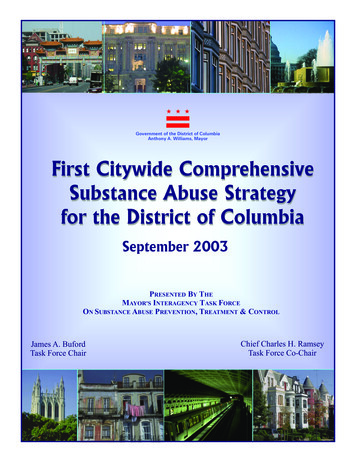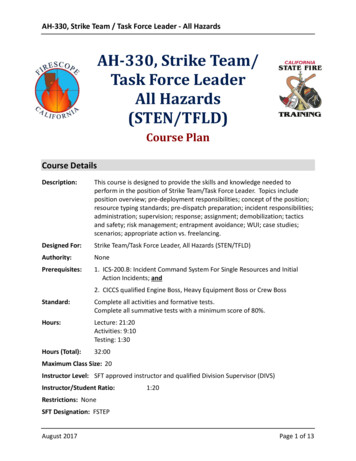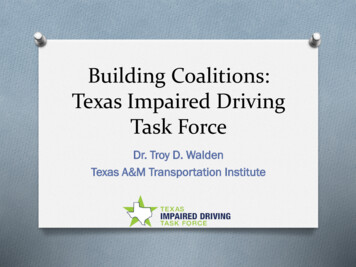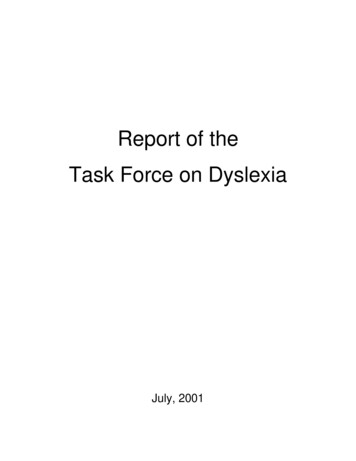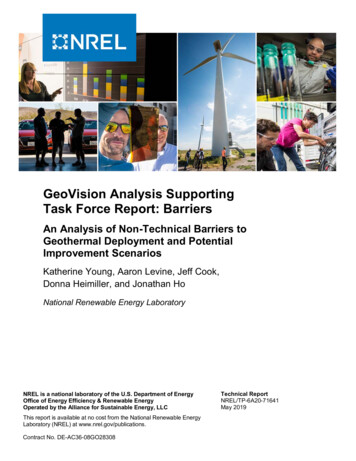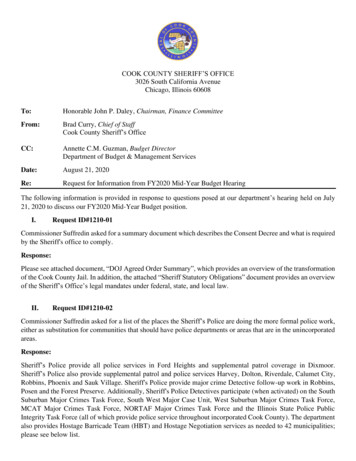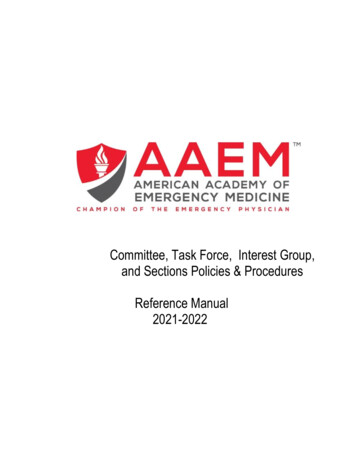
Transcription
Committee, Task Force, Interest Group,and Sections Policies & ProceduresReference Manual2021-2022
2021-2022 Reference ManualTable of ContentsAmerican Academy of Emergency Medicine About the AAEM . 4 AAEM History . 6Structure Overview AAEM Organizational Chart . 10Structure Overview . 11Board of Directors . 13Committees . 14Interest Groups. 19Sections. 20Committee, Interest Groups, and Sections Composition, Eligibility, Appointments & Terms . 21Policies & Expectations Communication on behalf of AAEM . 23Expectationso General . 23o Attendance & Compliance . 24o Code of Conduct Policy . 25o Meetings . 27Roles & ResponsibilitiesoooooBoard Liaison . 29Chair. 30Vice Chair . 31Committee Member . 31Advisor . 322021-2022 Objectives & GoalsooooCommittees . 33Task Forces. 35Interest Groups. 35Sections . 362as of 8.12.21
Procedureso Project Proposals . 37o Board Reports . 39o Clinical Practice Committee Statement Proposals . 40 Submitting a Board Approved CPC Paper to JEM. 44o Education Committee ACCME Subcommittee Application . 45 ACCME Subcommittee Disclosure Review . 46 Scientific Assembly Planning Subcommittee . 48 Speaker Development Group Subcommittee . 62o Ethics Committee Review of Ethics Complaint. forthcomingo International Conference Committee Approval of Recommended International Conferences . 66o Learning Management System Committee Approval of Content for the LMS . 67o Social Media Social Media Guidelines . 67Resources Staff Listing. 713
ABOUT AAEMAbout the American Academy of Emergency Medicine (AAEM)AAEM was established in 1993 to promote fair and equitable practice environments necessary to allowemergency physicians to deliver the highest quality of patient care.For over 25 years, AAEM has been a leader in protecting board certification in emergency medicine andconfronting the harmful influence of the corporate practice of medicine. We support fair and equitablepractice environments that allow emergency physicians to deliver the highest quality of patient care.Mission StatementAmerican Academy of Emergency Medicine (AAEM) is the specialty society of emergency medicine. AAEMis a democratic organization committed to the following principles:1. Every individual should have unencumbered access to quality emergency care provided by aspecialist in emergency medicine.2. The practice of emergency medicine is best conducted by a specialist in emergency medicine.3. A specialist in emergency medicine is a physician who has achieved, through personal dedicationand sacrifice, certification by either the American Board of Emergency Medicine (ABEM) or theAmerican Osteopathic Board of Emergency Medicine (AOBEM).4. The personal and professional welfare of the individual specialist in emergency medicine is aprimary concern to the AAEM.5. The Academy supports fair and equitable practice environments necessary to allow the specialist inemergency medicine to deliver the highest quality of patient care. Such an environment includesprovisions for due process and the absence of restrictive covenants.6. The Academy supports residency programs and graduate medical education, which are essential tothe continued enrichment of emergency medicine, and to ensure a high quality of care for thepatient.7. The Academy is committed to providing affordable high quality continuing medical education inemergency medicine for its members.8. The Academy supports the establishment and recognition of emergency medicine internationally asan independent specialty and is committed to its role in the advancement of emergency medicineworldwide.Vision StatementA physician's primary duty is to the patient. The integrity of this doctor-patient relationship requires thatemergency physicians control their own practices free of outside interference.We aspire to a future in which all patients have access to board certified emergency physicians.4
ABOUT AAEMThe Principles1. The ideal practice situation in emergency medicine affords each physician an equitable ownershipstake in the practice. Such ownership entails responsibility to the practice beyond clinical services.2. Emergency physicians should have control over their professional fees and should not engage infee-splitting.3. The role of emergency medicine management companies should be to help physicians managetheir practice. The practice should be owned by and controlled by its physicians and not by amanagement company.4. Medical societies should actively encourage the creation and enforcement of statutes prohibiting thecorporate practice of medicine.5. Medical societies should not accept financial support from entities that do not adhere to the aboveprinciples.6. Emergency medicine specialty societies should work towards the goal of establishing a workforcesufficient to ensure that all emergency departments in the United States and its territories arestaffed by emergency physicians certified by either the American Board of Emergency Medicine orthe American Osteopathic Board of Emergency Medicine.5
AAEM HISTORY1960sThe field of emergency medicine evolved out of the necessity of caring for a rapidly growing population ofpatients seeking immediate and unscheduled medical care for emergency conditions. By 1960, it becameclear that the number of emergency department visits was rising across the United States. Physicianslacked the necessary emergency medical skills to properly care for these patients and were frustrated bythe growing demand. In response, the Pontiac and Alexandria Plans were enacted in 1961. At PontiacGeneral Hospital (MI), 23 community physicians began working part-time to staff their emergencydepartment around-the-clock. In Alexandria (VA), another group of physicians left their private patients tobecome full-time emergency physicians.Though physicians began devoting varying degrees of their practices to emergency medicine, there wasstill a need for specialized training. In 1967, the American Medical Association (AMA) established acommittee on emergency medicine, and in 1968 John Wiegenstein and seven colleagues founded theAmerican College of Emergency Physicians (ACEP). ACEP's first Scientific Assembly was held in 1969.1970sIn 1970, the University Association for Emergency Medical Services (UAEMS) was formed for scientific andeducational purposes by medical school faculty practicing emergency medicine. Prior to its establishment,medical students were already choosing emergency medicine as a career path. The first universityemergency medicine residency arose at the University of Cincinnati in 1970 where Bruce Janiak becamethe initial resident. Other sentinel university programs include those at Los Angeles County/University ofSouthern California Medical Center (1971), the Medical College of Pennsylvania (1972), the University ofChicago (1972), and the University of Louisville (1973). R.R. Hannas established the first communityhospital emergency medicine residency in 1973 at Evanston Hospital (IL). The Emergency MedicineResidents Association (EMRA) was formed in 1974 to unite the initial residents in our field.The road to specialty recognition was particularly challenging. A provisional Section Council in emergencymedicine was established in the AMA House of Delegates in 1973 and became permanent in 1975. Also in1975, the Liaison Residency Endorsement Committee, the forerunner to the Residency Review Committeefor Emergency Medicine (RRC/EM) was created. In 1976, the American Board of Emergency Medicine(ABEM) was incorporated and the American Board of Medical Specialties (ABMS) finally recognizedemergency medicine in 1979. Unlike the boards of other fields, ABEM was initially required to be conjointwith other medical specialties represented.The emergence of osteopaths in the field occurred in 1975 when the American College of OsteopathicEmergency Physicians (ACOEP) became an affiliate college of the American Osteopathic Association(AOA). The first osteopathic emergency medicine residency began in 1979 and Gerald Reynolds becamethe initial resident at the Philadelphia College of Osteopathic Emergency Medicine. In July 1978, theAmerican Osteopathic Board of Emergency Medicine (AOBEM) was established as an affiliate specialtyboard of the AOA. ACOEP's first Scientific Assembly was held in 1978.6
AAEM HISTORY1980sABEM administered the first emergency medicine board examination in 1980 and AOBEM followed suit in1981. In 1982, the Accreditation Council for Graduate Medical Education (ACGME) approved specialrequirements for emergency medicine residency training programs.In 1988, after a well-publicized 10-year grace period, ABEM eliminated the practice track and began torequire emergency medicine residency training to qualify for the ABEM certification exam. Shortlyafterward, a one-time exception was granted to about 100 academic emergency physicians boarded ininternal medicine. The practice track for AOBEM certification is also effectively closed at this point since it isrestricted to those who began emergency medicine practice prior to 1986.The organization, Board of Certification in Emergency Medicine (BCEM), was formed in 1987 to create aloophole for those choosing to practice emergency medicine without formal training. That same year,BCEM certified the first group of physicians ineligible for ABEM or AOBEM certification.In 1989, emergency medicine became a primary board by ABMS. This recognition was dependent on,among other things, closing the ABEM practice track. Also in 1989, UAEMS and the Society for Teachersof Emergency Medicine (STEM) merged to become the Society for Academic Emergency Medicine(SAEM). The Council of Residency Directors (CORD) was formed later as a separate entity representingresidency program directors and their assistants.1990sThe 1990s brought turmoil to emergency medicine. In 1990, Gregory Daniel, a general surgeon practicingemergency medicine in Buffalo, New York, filed suit against ABEM and other individuals and institutions inacademic emergency medicine. He and numerous co-plaintiffs from the non-academic community allegedthat ABEM's closing of the practice track was the result of an illegal conspiracy to enhance the economicposition of board-certified emergency physicians. In 1991, the Association of Emergency Physicians (AEP),formerly called the Association of Disenfranchised Emergency Physicians, was formed with the goal ofreopening emergency medicine board certification for non-EM residency trained physicians. Dr. Danielserved on the AEP Board of Directors.In 1992, under the alias "The Phoenix," James Keaney published his notable book, which detailedcorruption that negatively impacted patient care. He maintained that exploitation of emergency physicianswas rampant. Many "leaders" in the field were siphoning significant profits through unfair business tacticsand hiring unqualified emergency physicians willing to work for less pay. This wake-up call beckoned theformation of the American Academy of Emergency Medicine (AAEM).AAEM was established in 1993 to promote fair and equitable practice environments necessary to allowemergency physicians to deliver the highest quality of patient care. Its first Scientific Assembly was held in1994. AAEM initially defined a specialist in emergency medicine as board-certified by ABEM and this7
AAEM HISTORYdefinition was later expanded to include those certified by AOBEM, pediatric emergency medicine (byABEM or the American Board of Pediatrics) and the Royal College of Physicians and Surgeons of Canada.The 1994 Macy Foundation Report entitled The Role of Emergency Medicine in the Future of AmericanMedical Care emerged from a conference requested by SAEM and chaired by the president of the NationalBoard of Medical Examiners. It was initially recommended that emergency medicine board certification berequired by the Joint Commission on Accreditation of Healthcare Organizations (JCAHO) to certifycomprehensive emergency departments. Unfortunately, the term "board-certified emergency physician"was replaced by "qualified emergency physician" after vigorous lobbying by ACEP to prevent dividing itsmembership. Some interpret "qualified emergency physician" as a physician trained in any field thatchooses to practice emergency medicine.In contrast, AAEM requires board certification in emergency medicine of each and every full votingmember. Currently, the only means of acquiring this is to complete an emergency medicine residency orpediatric emergency medicine fellowship.Beyond 2000The aforementioned Daniels lawsuit was dismissed in 2005, after an unsuccessful appeal by the plaintiffs.AAEM continues to lead efforts preventing the erosion of board certification by unrecognized organizationsthat hold themselves out as equivalent to ABEM and AOBEM. As of the current printing of the CommitteeReference Manual, we are working in California, Florida and Kentucky on this issue.Since the end of the millennium, there has been a steady rise in the number of large contract managementgroups (CMGs) acquiring emergency physician contracts. At this time, about one-third of all practicingemergency physicians work for one. This degree of "corporatization" far surpasses any other medicalspecialty and creates a tenuous situation for the future since emergency physician qualifications, workingconditions and professional compensation are tied to the bottom line of an economically volatile industry.AAEM believes that corporate ownership of emergency department contracts represents a violation of thepublic protections afforded by state prohibitions of the corporate practice of medicine. Additionally,emergency physicians may unwittingly risk their licensure by aiding and abetting the unlawful corporatepractice of medicine. The Board of Trustees of the AMA has provided a comprehensive review on theissue as it relates to practicing physicians. AAEM became involved with legal challenges regarding thecorporate practice of medicine with large corporations, TeamHealth in California and EmCare in the state ofMinnesota. AAEM also participated in a successful action related to the corporate practice of emergencymedicine in California involving Catholic Healthcare West.AAEM has raised concerns with the Office of the Inspector General and the Attorney General's Office invarious states that such corporate employment arrangements may involve prohibited fee-splitting activitiesunder current state and federal statutes. AAEM members are cautioned about accepting employment withcorporate groups and AAEM suggests that hospitals examine such an arrangement with due diligence.8
AAEM HISTORYAAEM believes that emergency physicians must remain free of corporate influence because of their difficultrole as advocates for the under and uninsured patient. The AAEM firmly believes it is in the best interest ofthe patients to have emergency physicians unencumbered by the profit concerns of a corporation. AAEM isalways willing to assist in this matter in order to help emergency physicians secure a physician-ownedgroup, which is the best model for professional satisfaction and care quality.In 2010, there were 157 allopathic and 37 osteopathic emergency medicine residency programs, whichcollectively accept about 2,000 new residents each year. Studies have shown that attending emergencyphysician supervision of residents directly correlates to a higher quality and more cost-effective practice,especially when an emergency medicine residency exists. The resident section of AAEM, which wasformed in 1999, became an organization independent of AAEM in 2005 called the AAEM Resident andStudent Association (or AAEM/RSA). Its purpose is to provide EM residents a forum and a means tospecifically address resident concerns and issues, develop their own programs and services and have arepresentative that can impact on the direction and mission of AAEM.9
AAEM ORGANIZATIONAL CHART10
STRUCTURE OVERVIEWBoard of DirectorsThe Board of Directors shall consist of the Academy’s president, immediate past president, president-elect,secretary-treasurer, past presidents council representative, president of the AAEM Resident and StudentAssociation, and no more than nine other directors, including a Young Physicians Section (YPS) memberdirector. The Board of Directors is responsible for the direction of the Academy and long-term planning.The Board of Directors shall also include the current JEM and Common Sense editor as an ex-officio andnon-voting board member.Executive CommitteeThe Executive Committee shall consist of the AAEM president, immediate past president, president-elect,secretary/treasurer and past presidents’ council representative. The Executive Committee shall have theauthority to act on behalf of the Board of Directors subject to ratification by the Board. The ExecutiveCommittee shall meet at the call of the AAEM president, president-elect or secretary/treasurer. A report ofits actions shall be given to the Board. Any tie vote of the Executive Committee may be decided by theAAEM president.CommitteeEstablished through the AAEM Bylaws as a collection of AAEM members in good standing appointed by theAAEM president/president-elect, in consultation with the Board of Directors liaison and the currentcommittee chair, on an annual basis to accomplish well defined, ongoing objectives that impact theAcademy on a continuous basis. These committees will address broad-based issues and may be inexistence for many years. They will advise the Board on issues important to the Academy. Each committeewill have a chair responsible for its direction, productivity and meetings. This chair and members will beappointed by the AAEM president/president-elect.Task ForceEstablished by the Board of Directors as a collection of AAEM members in good standing to addressspecific issues over a specific time interval. Goals will be determined by the AAEM president/presidentelect. A Board liaison will be appointed by the AAEM president/president-elect. Each taskforce will have achair responsible for its direction, productivity and meetings. When assigned goals are met, task forces aretypically dissolved at the discretion of the Board. Taskforce committee chair and members will be appointedby the AAEM president/president-elect.Special Interest GroupsEstablished by the president and/or Executive Committee as a group of AAEM members who have acommon interest that impacts both the Academy and Emergency Medicine as a specialty not covered byeither a committee or taskforce. Dues will be determined by the AAEM BOD and will be used to supportproductivity and communications of the group such as included Listserv access, mailings and a meetingroom each year at the Scientific Assembly. A BOD liaison will be appointed by the President and/orExecutive Committee. Each Special Interest Group will have a Chair responsible for its direction,productivity and meetings. This chair will be selected by the Interest Group by a majority vote.SectionsThe Board of Directors of the Academy may approve the formation of membership sections by members ofthe Academy. Establishment of a new section must be approved by a majority vote of the Board ofDirectors. Each section will have their own bylaws that conform to the bylaws of the Academy and begoverned by a section board. The section board will consist of a section chair, section immediate past chair,section chair-elect and secretary-treasurer. Additional members of the board will be defined by their bylaws.11
STRUCTURE OVERVIEWChapter DivisionsThe Board of Directors of the Academy may approve the formation of Chapter Divisions in a state or regionby members of the Academy. Chapter Divisions complete an agreement to establish a Chapter Divisionwithin AAEM. As a division of AAEM, a Chapter Division exists and operates under the ultimate auspicesand control of AAEM. Membership to a Chapter Division does not require or equate to membership of theAcademy. Each Chapter Division will have their own bylaws that conform to the bylaws of the Academy andbe governed by a Chapter Division board. The business and affairs of Chapter Division shall be managedby its Board of Directors, the power and authority of which shall be subject to such coordination, oversightand control by AAEM as it may determine in its discretion from time to time. The initial officers and directorsshall be appointed by AAEM Board and shall hold office for a term of one (1) year or until their successorsare duly elected and qualified. Thereafter the term of a president, vice-president, secretary, treasurer anddirectors is one (1) year. No officer or board member may hold more than one position on the board at atime. Term limitations of two (2) consecutive terms are established for Board of Directors Officers andMembers at Large.12
BOARD OF DIRECTORSIn AAEM, any individual Full Voting or Emeritus member can be nominated and elected to the Board of Directors.Any YPS member can be nominated and elected to the YPS director position. YPS membership is open to allAssociate or Full Voting members who are within the first five years of professional practice after residency orfellowship training.EXECUTIVE COMMITTEELISA A. MORENO, MD MS MSCR FIFEMPresidentNew Orleans, LAJONATHAN S. JONES, MDPresident-ElectJackson, MSROBERT FROLICHSTEIN, MDSecretary-TreasurerSan Antonio, TXDAVID A. FARCY, MD FCCMImmediate Past PresidentMiami Beach, FLWILLIAM T. DURKIN, JR., MD MBA MAAEMPast Presidents CouncilAlexandria, VABOARD OF DIRECTORSPHILLIP DIXON, MD MPH FAAEM CHCQM-PHYADVAt-Large Board MemberColumbus, OHVICKI NORTON, MDAt-Large Board MemberBoca Raton, FLAL O. GIWA, LLB MD MBA MBE FAAEMAt-Large Board MemberBrooklyn, NYCAROL PAK-TENG, MDAt-Large Board MemberSummit, NJL.E. GOMEZ, MD MBAAt-Large Board MemberAnnapolis, MDFRED E. KENCY, JR., MD FAAEMYPS DirectorMadison, MSROBERT P. LAM, MD FAAEMAt-Large Board MemberColorado Springs, COLAUREN LAMPARTER, MAAEM/RSA PresidentChicago, ILBRUCE LO, MD MBA RDMSAt-Large Board MemberVirginia Beach, VAEX-OFFICIO BOARD MEMBERSSTEPHEN R. HAYDEN, MDEditor, JEMSan Diego, CATERRENCE MULLIGAN, DO MPHAt-Large Board MemberBaltimore, MDANDY MAYER, MDEditor, Common SenseNew Orleans, LA13
COMMITTEESCommittees are established through the AAEM bylaws as a collection of AAEM members in good standingappointed by the AAEM president, in consultation with the Board of Directors liaison and the currentcommittee chair, on an annual basis to accomplish well-defined, ongoing objectives that impact theAcademy on a continuous basis. These committees will address broad-based issues and may be inexistence for many years. They will advise the Board on issues important to the Academy. Each committeewill have a chair responsible for its direction, productivity and meetings. The chair and members ofcommittee’s will be appointed by the AAEM president/president-elect.Academic AffairsThe Academic Affairs Committee provides leadership in the area of academic advocacy. They serve as theliaison to CORD, SAEM, AACEM, NAEMSP and other EM organizations for joint interests and projects.Academic Affairs works with academic departments of EM and in particular EM residency programs inorder to establish a connection with AAEM at the early stages of resident training and to provide theresources necessary to develop an understanding of the goals of the Academy.Leadership: Chair: Joshua Joseph, MD MS FAAEM; Vice Chair: Leslie Ann Bilello, MDClinical PracticeThe focus of the AAEM Clinical Practice Committee is to write evidence-based clinical practice statementson current issues that impact emergency medicine physicians. View all Clinical Practice Statements.Leadership: Chair: Michael Abraham, MD FAAEM; Vice Chair: Grzegorz Karol Waligora, MDDiversity, Equity and InclusionThe mission of the DEI is to strive for increased diversity throughout the practice of emergency medicineand to reduce inequity beginning at AAEM and extending to all of our affiliate institutions and beyond.Leadership: Co-Chairs: Paul Peterson, MD FAAEM and Joanne Williams, MD MAAEM FAAEM;Co-Vice Chairs: Brianna Wapples, MD and Italo Brown, MDEducationThe purpose of the Education Committee is to develop and coordinate the Annual Scientific Assembly, oraland written board courses as well as explore new venues to provide AAEM members with the best possibleeducational resources including access to online services, journals and meetings. In addition, thecommittee explores collaborative efforts with other local, national and international EM organizations toprovide educational resources and meetings to AAEM members.Leadership: Chair: Teresa Ross, MD FAAEM; Vice Chair: David Carlberg, MD FAAEMEducation SubcommitteesACCMEThe ACCME Subcommittee is responsible for ensuring AAEM stays accredited to provide CMEactivities and approves directly, jointly, and recommended CME activities.Leadership: Co-Chairs: Tamara Dildy, MD FAAEM and Indrani A. Sheridan, MD FAAEM; Vice Chair:Sara A. Misthal, MD FAAEMOral Board Review CourseThe Oral Board Review Course Subcommittee is responsible for planning each series of AAEM'sPearls of Wisdom Oral Board Review Courses, one series in the spring and one in the fall. Thesecourses prepare physicians to sit for their oral board examinations.14
COMMITTEESLeadership: Advisor: Mitchell Goldman, DO FAAEM; Chair: Frank Christopher, MD FAAEM; ViceChair Michael C. Bond, MD FAAEM FACEPScientific AssemblyThe Scientific Assembly Subcommittee is responsible for planning AAEM's Annual Scientific Assemblyprogram.Speaker Development GroupThe Speaker Development Group matches emerging interested individuals who would like to benational speakers with a mentor who is a nationally recognized AAEM speaker. The goal for theSpeaker Development Group is to help mentees become confident, polished, and engaged speakers.Leadership: Chair: Kevin Reed, MD FAAEMWritten Board Review CourseThe Written Board Review Course Subcommittee is responsible for planning the online and in-personAAEM Written Board Review Course. This course prepares physicians to sit for both their Qualifyingand ConCertTM Exams.Leadership: Co-Chair: Michael Silverman, MD FAAEM FACP and Michael Winters, MD MBA FAAEM;Vice Chair: Laura Bontempo, MD Med FAAEMEmergency Medicine Workforce CommitteeThe AAEM EM Workforce Committee is one of the most active committees of AAEM. They are activelyengaged in advocacy issues that speak to the
(AOA). The first osteopathic emergency medicine residency began in 1979 and Gerald Reynolds became the initial resident at the Philadelphia College of Osteopathic Emergency Medicine. In July 1978, the American Osteopathic Board of Emergency Medicine (AOBEM) was established as an affiliate specialty board of the AOA.

